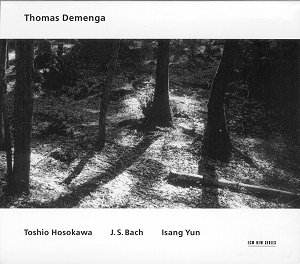Demenga’s recordings of Bach’s suites for solo cello
were launched as far back as 1986. From the start, he included works
by contemporary composers (Zimmermann, Carter, Veress, Holliger). This
double CD set is the last instalment in this thought-provoking series.
It is likely to fascinate as well as irritate depending on the listener’s
likes and dislikes. Like it or not, the contemporary pieces featured
here would have been unthinkable without Bach’s innovative thinking
and writing as displayed in his Cello Suites. The present recordings
of Bach’s suites are confronted with works by two Eastern composers
who were admirers of Bach’s music as well as clear products of their
respective cultures (though they were trained in Europe). The Korean-born
Isang Yun and the Japanese-born Toshio Hosokawa, a pupil of Yun, try
to find a meeting point between Western and Eastern musical traditions
while as far as possible preserving their cultural roots.
Though his early mature works inevitably bore the imprint
of the musical avant-garde of the 1960s, Yun soon found his own way
of blending Western and Eastern influences into a highly personal whole.
This balance characterises most of his later output culminating in five
substantial symphonies, a number of concertos, operas and a large number
of chamber works including several string quartets and two clarinet
quintets. Gasa of 1963 is the earliest work here in which
Yun’s quest for a personal musical thinking is still under weigh. There
is still much in this piece that reflects Yun’s formal concerns and
preoccupations with some aspects of the then prevailing Serialism though
he never adopted it unreservedly, as well as with some Eastern playing
techniques. This is particularly evident in the violin part. Gasa
is a virtuoso work of considerable technical difficulty, though never
gratuitously so.
By comparison, Images (flute, oboe, violin
and cello) is almost impressionistic and definitely achieves the kind
of synthesis that Yun was aiming at. As such, it might be one of his
first mature works and an important milestone in Yun’s musical progress.
As in Gasa, the music alternates energetic, rhythmically
alert episodes and peaceful, meditative moments, a "continuous
repetition of Yin-Yang principles", to quote the composer’s
own words. (It seems that the present recording has been available on
a Japanese CD before [CAMERATA 32CM-108], though the information concerning
that recording mentions DRS Basel rather than DRS Zürich as mentioned
here.]
The much later Espace 1 for cello and
piano is a prime example of the composer’s hard-won tone of voice. This
beautiful piece is also quite accessible and could well earn Yun many
new admirers. It unfolds in continuous alternations and relaxations
before reaching a moving coda of great beauty.
Hosokawa is represented by works situated at both ends
of his composing career. Winter Bird of 1978 is one of
the few early works he still acknowledges. This is a free fantasy for
solo violin still rather redolent of the prevailing Western avant-garde,
though it already displays some beautiful lyrical moments.
In der Tiefe der Zeit ("In the Depth
of Time") is a substantial study in sound written for the rather
unusual combination of cello and accordion. The accordion functions
as a Western equivalent of the sho (Japanese mouth-organ). It
is sparingly but tellingly used; and its pedal notes, constantly varied
dynamically, provide for a firm ground supporting the cello’s flights
of fancy. These excursions reach some intense climaxes in the course
of the piece. It is a long and difficult work and the cello part is
fiendishly demanding. The music communicates by the sheer force of its
inventiveness and its subtle poetic feel.
The recent Duo for violin and cello is
another example of Hosokawa’s approach to music and, paradoxically,
to silence which he views as important and meaningful as the sounds
themselves. Silence plays a leading part in this piece which is much
more violent in mood than In der Tiefe der Zeit. The composer
sometimes enlarges his expressive palette by using some spectral techniques,
but this is always discreetly done and is always in the service of expressive
ends.
In short, a typical ECM production (and a quite generous
one): thought-provoking, often fascinating and quite rewarding in its
own peculiar way. Masterly playing of Demenga and his colleagues caught
in superb recordings. No easy stuff, though, but well worth the effort.
Hubert Culot
